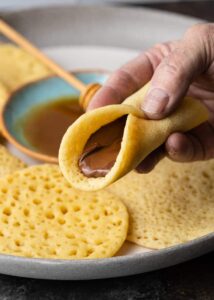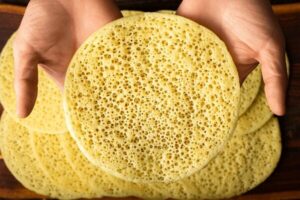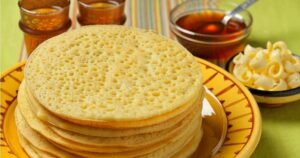Baghrir: The Legendary Moroccan Pancakes with a Thousand Holes

Baghrir, also known as the Moroccan pancakes with a thousand holes, is a type of traditional pancake famous in Morocco. It is characterized by its delicate texture and the small holes that cover its surface, making it look like a sponge. These holes help absorb the mixture of melted butter and honey well. This known combination, along with a hot and fresh cup of mint tea or coffee, forms a favorite meal for many Moroccans. Baghrir is part of Morocco’s cultural and culinary heritage, dating back to ancient…
History and Origin of Baghrir
In fact, the exact origin of Baghrir has not been determined, but it is believed that these pancakes have roots tracing back to the ancient days of North African cuisine. Over the centuries, this recipe has been passed down from generation to generation, becoming an integral part of Moroccan culinary culture. Baghrir has gained worldwide fame and is now enjoyed by many people around the world, as testified by everyone who has tasted it. The history of Baghrir dates to ancient times in Morocco, where…
Why does Baghrir have so many holes?
There is no doubt that what makes these pancakes special is the shape of those holes that cover the surface of Baghrir. You may wonder why exactly this unique shape appears. The matter is quite simple. It relates to two reasons: first, adding yeast to the mixture when preparing it, and second, cooking it in a pan on one side only, allowing the bubbles to appear on the top side, leading to the creation of those small holes.
How to Prepare Baghrir

Cooking this delicious pancake is easier than you might think. Baghrir is made from simple and available ingredients in every Moroccan household. The basic ingredients for Baghrir include semolina flour, white flour, lukewarm water, yeast, salt, sugar, and baking powder. These simple ingredients play a significant role in achieving the perfect texture and delicious taste of Baghrir.
Step 1: Preparing the Mixture
In a large bowl, mix semolina flour and white flour together. Then, add salt, sugar, instant yeast, and baking powder to the mixture and mix well. After that, gradually add lukewarm water to the mixture while continuously stirring until you have a smooth and lump-free mixture. Unlike other pancakes, you generally want to ensure not to over-mix, but that is not the case here. For Baghrir, the batter should be relatively thin, so thorough mixing helps make it smooth.
Step 2: Fermentation
Leave the mixture to ferment in a warm place for about 30 minutes to an hour until it doubles in size and bubbles appear on the surface. Fermentation is an essential and crucial step to ensure you get light and hole-filled Baghrir.
Step 3: Cooking
Heat a pan, preferably non-stick or a crepe pan, over medium heat. Then, pour a moderate amount of the mixture into the pan and let it cook on one side only until the top dries and holes form. Baghrir is distinguished by the small holes that appear on its surface during cooking, which is a sign of successful cooking. Avoid flipping Baghrir to maintain its light texture. If the result is raw or the shape is odd, the mixture you poured might be too thick, so try thinning it with a bit of water.
Step 4: Serving
Finally, after successfully cooking Baghrir, it’s time to serve it. Baghrir is usually served with melted butter and honey or jam. It can also be served with Moroccan mint tea or coffee to add a traditional touch to the meal.
Various Serving Methods:
Baghrir can be served at different times of the day and in various ways. It can be served for breakfast but also as a light evening meal alongside mint tea or coffee. Baghrir is also popular during Ramadan, where it is served on Iftar tables. These pancakes are very popular, and the ways of eating them may vary from person to person or region to region. The traditional and known way to eat Baghrir is to add a mixture of equal amounts of melted butter and honey, spread it over the Baghrir pieces, and serve…
Baghrir in Social Occasions

Baghrir is an essential part of the Moroccan table during social and religious occasions. It is prepared in large quantities during the holy month of Ramadan to be eaten at Iftar and is also served during holidays and family gatherings. Preparing and serving Baghrir is a symbol of generosity and hospitality in Moroccan culture. The influence of Baghrir extends beyond Moroccan cuisine, reaching popular culture as well. Baghrir appears in many Moroccan stories and tales, symbolizing authenticity and herita…
Preserving the Heritage of Baghrir
In the modern era, with the development of cooking methods and the emergence of new recipes, Baghrir retains its place in Moroccan cuisine. Many strive to preserve traditional Baghrir recipes and teach them to new generations to ensure the continuity of this rich culinary heritage. Workshops and educational seminars on preparing Baghrir are part of the efforts made to preserve this culinary culture.
Conclusion
Baghrir, known as the pancakes with a thousand holes, is a type of traditional pancake famous in Morocco. It is characterized by its delicate texture and the small holes on its surface. It is usually served as a breakfast meal or a light meal at any time of the day and can be eaten with a variety of sauces and ingredients such as butter, honey, or traditional Moroccan tea.
Moroccan Baghrir is part of the cultural and heritage identity of Morocco. With its delicious taste and light texture, Baghrir continues to bring people together around the table, whether during special occasions or in daily life. The process of preparing and serving it expresses love and generosity, making it a lasting symbol of Moroccan authenticity.
